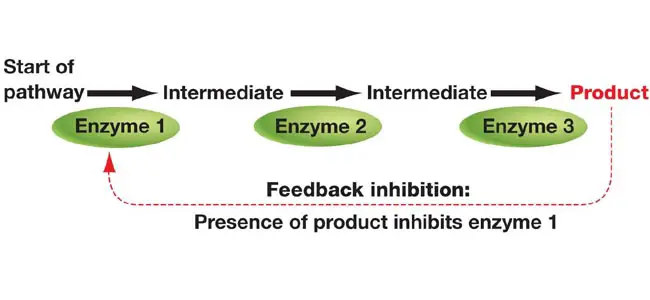Feed-back inhibition:
 Q.1Reaction products inhibit catalysis in enzymes by:
Q.1Reaction products inhibit catalysis in enzymes by:
A: TSH
B: thyroid stimulating IgM
C: TRH
D: parathyroid hormone
Which of the following combination of above statements is correct?
a) A and B
b) B and C Ans.B
c) A and C
d) B and D
b) End product
c) Temperature
d) Substrate Ans.B
(B) not increase
(C) decrease
(D) increase till feed back inhibition Ans.D
2.enzyme induction
3.feed back inhibition (Ans.)
4.channeling
b. is slower acting
c. stops the action of preexisting enzymes Ans. C
d. stops the synthesis of new enzymes
- An allosteric enzymatic activity regulation mechanism in the cell to regulate metabolic pathways with more than one steps and includes more than one enzyme.
- Usually the first enzyme in these metabolic pathways will be an allosteric enzyme. Allosteric enzymes have “other sites” for the binding of modulators. Binding of modulators may stimulate or inhibit the activity of allosteric enzyme temporarily for short period of time.
- In feed-back inhibition, the end product of the metabolic pathway act as the negative modulator which binds to the allosteric site of the first enzyme and thereby making it unable to bind to the substrate and ultimately halts the metabolic pathway for a period of time until all the end products are consumed. The modulator only binds non-covalently (temporarily) to the allosteric enzyme.
- Feedback inhibition works by deactivating an enzyme using the product of the reaction the enzyme catalyzes. Enzymes bind to molecules with active sites that are specifically designed to fit with the molecule undergoing the reaction. These enzymes have a second active site for the reaction product to bind to. This causes the enzyme to spatially re-arrange so it can no longer bind to the initial reagent and the reaction stop.
- Citrate is used for feedback inhibition, as it inhibits phosphofructokinase, an enzyme involved in glycolysis that catalyses formation of fructose 1,6-bisphosphate, a precursor of pyruvate. This prevents a constant high rate of flux when there is an accumulation of citrate and a decrease in substrate for the enzyme.
 Q.1Reaction products inhibit catalysis in enzymes by:
Q.1Reaction products inhibit catalysis in enzymes by:
a. Covalent binding to the enzyme
b. Altering the enzyme structure
c. Occupying the active site
d. Form a complex with the substrate
b. Altering the enzyme structure
c. Occupying the active site
d. Form a complex with the substrate
Ans: b- Altering the enzyme structure
Q2. A woman patient suffering from thyrotoxicosis shows high level of thyroxine in the blood which is attributed to failure in feed back inhibition in hypothalamic-pituatory-thyroxine circuit. If we further check blood in detail, patient will also show high level ofA: TSH
B: thyroid stimulating IgM
C: TRH
D: parathyroid hormone
Which of the following combination of above statements is correct?
a) A and B
b) B and C Ans.B
c) A and C
d) B and D
Q3.Which factor is responsible for inhibition enzymatic process during feed back?
a) Enzymesb) End product
c) Temperature
d) Substrate Ans.B
Q4.Intensity of light increase 20 times, rate of photosynthesis will
(A) increase (B) not increase
(C) decrease
(D) increase till feed back inhibition Ans.D
Q5.The ability of CTP (cytidine triphosphate) to bind to aspartate carbomyltransferase and shut down the synthesis of more CTP is an example of-
1.enzyme repression2.enzyme induction
3.feed back inhibition (Ans.)
4.channeling
Q6.Feedback inhibition differs from repression because feedback inhibition
a. is less preciseb. is slower acting
c. stops the action of preexisting enzymes Ans. C
d. stops the synthesis of new enzymes
Thank you for visiting my blog.Please feel free to share your comment on this article ,Please subscribe and share the articles to get more such articles.

No comments:
Post a Comment